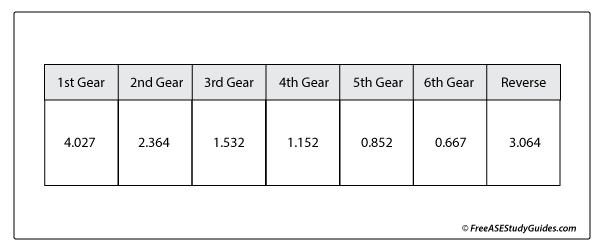ASE A2 Automatic Transmission Practice Test

46. Refer to the chart above. Which gear ratio best represents overdrive?
- A. 4.027:1
- B. 0.852:1
- C. 3.064:1
- D. None of these.
47. A transaxle's final drive assembly has been replaced. Use which of the following to measure ring gear backlash?
- A. An inch-pound torque wrench.
- B. An outside micrometer.
- C. A dial indicator.
- D. A straightedge and feeler gauge.
48. Technician A says an automatic transmission multiple friction disc clutch can drive a member of the planetary gear set. Technician B says a multiple friction disc clutch can ground a member to the transmission case. Who is correct?
- A. Technician A
- B. Technician B
- C. Both A and B
- D. Neither A or B
49. An automatic transmission will not shift out of PARK. Technician A says a faulty shift interlock solenoid will result in this condition. Technician B says this could be caused by a faulty brake switch. Who is correct?
- A. Technician A
- B. Technician B
- C. Both A and B
- D. Neither A or B
50. Technician A says the test ports to retrieve hydraulic pressure readings for the line, clutch, and servo circuits are located on the transmission case. Technician B says to perform air pressure tests before and after transmission disassembly. Who is correct?
- A. Technician A
- B. Technician B
- C. Both A and B
- D. Neither A or B